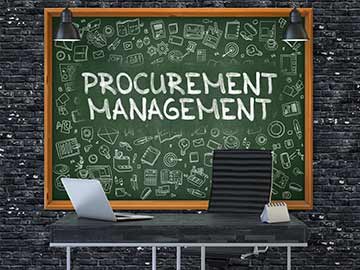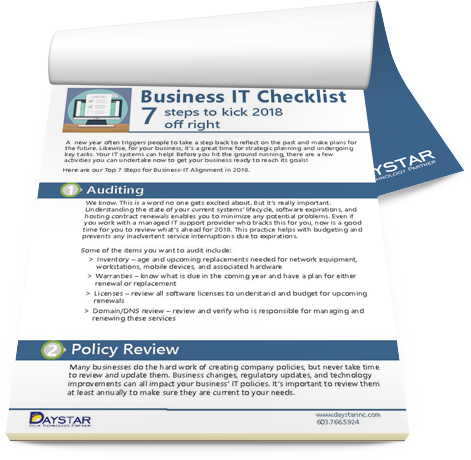Every year brings new technology and the feeling that what you have might now be outdated or obsolete. It’s frustrating to spend large chunks of your budget on IT procurement when devices seem to lose their relevance every few years. It’s a cycle many businesses enter into, without realizing there’s a way out.
Carefully planning your IT purchases can help you feel confident in your investments and choose technology that will serve you long into the future. In this article, we’ll show you how to refine your IT procurement process so it’s both efficient and cost-effective.
When was the last time you checked in on your IT performance?
The Business IT Checklist shows you the 7 steps you need to take to enhance your business technology immediately.
What Is IT Procurement?
Similar to standard procurement practices, IT procurement is the process of acquiring technology for your business needs. This could be anything from new computers to cybersecurity to software that offers automation.
Unless you’re an IT procurement specialist, determining your IT needs is difficult. You likely aren’t aware of what IT products are out there that could solve even small problems in your business. For this reason, a critical portion of the procurement process is taking stock of what you already have. It’s important to analyze what information technology your business is currently using and whether or not it’s moving you closer to your goals.
Outsourced IT Procurement: Small vs. Large Businesses
Small Businesses
The IT industry is complex, so naturally IT procurement management can be too. Handling IT procurement in-house is quickly overwhelming for small businesses, even those with as few as 10 employees. Pricing, sourcing, and purchasing new IT assets requires special knowledge of IT systems, your business needs, and the supply chain. Few small businesses are equipped with a procurement team that has the know-how to find cost saving opportunities and secure strategic procurement contracts.
To avoid costly missteps, many small businesses opt for outsourced IT procurement. Forming a partnership with a dedicated IT company means there are experts monitoring the total cost of your purchases as well as offering help with asset management, cybersecurity, and more.
Small businesses can benefit greatly from this level of outsourced IT support. The procurement process will look different depending on what company you work with, but most workflows are detailed and efficient. At Daystar, we hold biannual meetings with our clients to discuss strategic procurement planning and manage sourcing and purchasing based on that plan. We can often secure better prices in the purchasing phase because we have economies of scale and elevated channels of procurement that individual small businesses don’t have access to.
Working with an outside company also means help with monitoring metrics and tracking progress throughout the entire IT project. We use dedicated client success managers and a virtual CIO to maintain up-to-date equipment inventories and a lifecycle refreshment calendar that informs a 3-5 year IT budget. It can even address gaps in a business’s IT infrastructure and show them what investments could best help them reach their goals.
Large Businesses
Mid-sized and large businesses have more options when it comes to managing their IT procurement process. Many have established procurement teams with the capabilities to approach IT purchases strategically, so they might opt to keep that process in-house. That keeps all of their procurement tasks together, which makes it easier to perform audits of equipment and purchase orders.
This doesn’t mean those businesses have to do everything on their own. In fact, many opt to work with an MSP for guidance on big decisions then handle the actual purchasing on their own. It just depends on the size of the staff, the capabilities of the procurement team, and how much help you need.
Best Practices
With so many different approaches to IT procurement, it can seem like there’s no hard and fast rules for what’s right. But there are a few best practices any size business can use to keep its processes organized and its planning on track.
First and foremost, focus on technology that aligns with your business needs. It’s easy to get distracted by the latest software and devices, but not all of them will fit neatly into your organization. For example, an office management software geared toward healthcare businesses wouldn’t serve a financial advisor, no matter how powerful it is. Look at assets and services that will promote productivity, efficiency, safety, and profitability for your business specifically.
After finding the right items, you need to address vendor management. Try to make strategic partnerships with your vendors or service providers so there’s room to grow with them. A technology equipment vendor might help you stay up to date on any supply chain issues and plan ahead. An outsourced IT service provider can help you gradually scale your business technology as your organization grows.
Throughout the entire process, you need to focus on mitigating risk. All business purchases include some type of risk, but technology purchases can be some of the most pricey. To feel confident in your purchases, conduct a full risk analysis before purchasing any kind of new IT assets and determine the probability for financial loss. Also, remember to always opt into product warranties if they aren’t automatically applied because they help reduce the risk in an expensive purchase.
Finally, the most important practice in IT procurement planning is looking ahead. You always want to plan and purchase for the future, not the present. Some IT systems and devices have such short life cycles, they’re obsolete by the time you grow accustomed to using them. Instead, opt for time tested software like Microsoft and other industry-standard applications that you can easily update on all your devices as changes are needed.
Benefits of Strategic IT Procurement
Strategically planning your IT purchases helps you manage your IT budget and coordinate investments with business growth and goals. More specifically, the process help you:
- Save money. The procurement process forces you to look at your IT purchases as strategic business moves. That means you can not only work to secure better prices on single purchases, but also plan your spending so those purchases offer the most return at critical times during your business cycles.
- Build necessary redundancies. Odds are your business is cyclical and you need extra resources at certain points in the year. Planning procurement allows you to create IT initiatives that address these needs and create necessary redundancies in your resources or workflows to support you at your busiest times.
- Create transparency. With a detailed procurement process, everything is recorded and saved for others to double check. This can help to increase accountability in your IT department and better solve recurrent problems.
- Access continuous measurement. IT procurement planning also means you have plenty of data to measure throughout the year. Each time those strategic decisions come around again, you can look at previous IT performance to determine what services are worth renewing and which should be reevaluated.
- Develop your future. Set yourself up for success. Use the information you gather in the procurement process to inform decisions that will continue benefiting your business as it grows. Choose products or services that can help you scale your business over time and support long-term success.
If creating a plan on your own is stressful or you simply don’t have the manpower to dedicate to IT planning, don’t worry. When you outsource your IT needs, you get access to a partner who’s an expert in the IT procurement process. We’d love to help you create a strategy that can bolster your business and fulfill all your IT needs. Contact us today to see how we can help!














